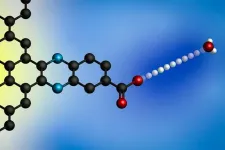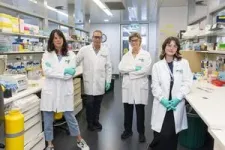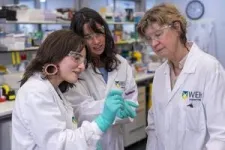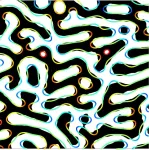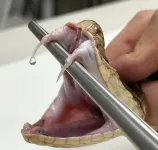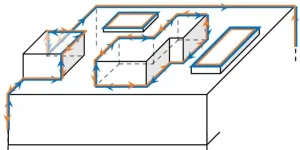(Press-News.org) CAMBRIDGE, MA — A key chemical reaction — in which the movement of protons between the surface of an electrode and an electrolyte drives an electric current — is a critical step in many energy technologies, including fuel cells and the electrolyzers used to produce hydrogen gas.
For the first time, MIT chemists have mapped out in detail how these proton-coupled electron transfers happen at an electrode surface. Their results could help researchers design more efficient fuel cells, batteries, or other energy technologies.
“Our advance in this paper was studying and understanding the nature of how these electrons and protons couple at a surface site, which is relevant for catalytic reactions that are important in the context of energy conversion devices or catalytic reactions,” says Yogesh Surendranath, a professor of chemistry and chemical engineering at MIT and the senior author of the study.
Among their findings, the researchers were able to trace exactly how changes in the pH of the electrolyte solution surrounding an electrode affect the rate of proton motion and electron flow within the electrode.
MIT graduate student Noah Lewis is the lead author of the paper, which appears today in Nature Chemistry. Ryan Bisbey, a former MIT postdoc; Karl Westendorff, an MIT graduate student; and Alexander Soudackov, a research scientist at Yale University, are also authors of the paper.
Passing protons
Proton-coupled electron transfer occurs when a molecule, often water or an acid, transfers a proton to another molecule or to an electrode surface, which stimulates the proton acceptor to also take up an electron. This kind of reaction has been harnessed for many energy applications.
“These proton-coupled electron transfer reactions are ubiquitous. They are often key steps in catalytic mechanisms, and are particularly important for energy conversion processes such as hydrogen generation or fuel cell catalysis,” Surendranath says.
In a hydrogen-generating electrolyzer, this approach is used to remove protons from water and add electrons to the protons to form hydrogen gas. In a fuel cell, electricity is generated when protons and electrons are removed from hydrogen gas and added to oxygen to form water.
Proton-coupled electron transfer is common in many other types of chemical reactions, for example, carbon dioxide reduction (the conversion of carbon dioxide into chemical fuels by adding electrons and protons). Scientists have learned a great deal about how these reactions occur when the proton acceptors are molecules, because they can precisely control the structure of each molecule and observe how electrons and protons pass between them. However, when proton-coupled electron transfer occurs at the surface of an electrode, the process is much more difficult to study because electrode surfaces are usually very heterogenous, with many different sites that a proton could potentially bind to.
To overcome that obstacle, the MIT team developed a way to design electrode surfaces that gives them much more precise control over the composition of the electrode surface. Their electrodes consist of sheets of graphene with organic, ring-containing compounds attached to the surface. At the end of each of these organic molecules is a negatively charged oxygen ion that can accept protons from the surrounding solution, which causes an electron to flow from the circuit into the graphitic surface.
“We can create an electrode that doesn’t consist of a wide diversity of sites but is a uniform array of a single type of very well-defined sites that can each bind a proton with the same affinity,” Surendranath says. “Since we have these very well-defined sites, what this allowed us to do was really unravel the kinetics of these processes.”
Using this system, the researchers were able to measure the flow of electrical current to the electrodes, which allowed them to calculate the rate of proton transfer to the oxygen ion at the surface at equilibrium — the state when the rates of proton donation to the surface and proton transfer back to solution from the surface are equal. They found that the pH of the surrounding solution has a significant effect on this rate: The highest rates occurred at the extreme ends of the pH scale — pH 0, the most acidic, and pH 14, the most basic.
To explain these results, researchers developed a model based on two possible reactions that can occur at the electrode. In the first, hydronium ions (H3O+), which are in high concentration in strongly acidic solutions, deliver protons to the surface oxygen ions, generating water. In the second, water delivers protons to the surface oxygen ions, generating hydroxide ions (OH-), which are in high concentration in strongly basic solutions.
However, the rate at pH 0 is about four times faster than the rate at pH 14, in part because hydronium gives up protons at a faster rate than water.
A reaction to reconsider
The researchers also discovered, to their surprise, that the two reactions have equal rates not at neutral pH 7, where hydronium and hydroxide concentrations are equal, but at pH 10, where the concentration of hydroxide ions is 1 million times that of hydronium. The model suggests this is because the forward reaction involving proton donation from hydronium or water contributes more to the overall rate than the backward reaction involving proton removal by water or hydroxide.
Existing models of how these reactions occur at electrode surfaces assume that the forward and backward reactions contribute equally to the overall rate, so the new findings suggest that those models may need to be reconsidered, the researchers say.
“That’s the default assumption, that the forward and reverse reactions contribute equally to the reaction rate,” Surendranath says. “Our finding is really eye-opening because it means that the assumption that people are using to analyze everything from fuel cell catalysis to hydrogen evolution may be something we need to revisit.”
The researchers are now using their experimental setup to study how adding different types of ions to the electrolyte solution surrounding the electrode may speed up or slow down the rate of proton-coupled electron flow.
“With our system, we know that our sites are constant and not affecting each other, so we can read out what the change in the solution is doing to the reaction at the surface,” Lewis says.
###
The research was funded by the U.S. Department of Energy Office of Basic Energy Sciences.
END
Study reveals a reaction at the heart of many renewable energy technologies
New insights into how proton-coupled electron transfers occur at an electrode could help researchers design more efficient fuel cells and electrolyzers.
2024-01-16
ELSE PRESS RELEASES FROM THIS DATE:
Water as a nonlinear medium for ultrabroadband white laser
2024-01-16
Scientists are making significant strides in the development of ultrabroadband white laser sources, covering a wide spectrum from ultraviolet to far infrared. These lasers find applications in diverse fields such as large-scale imaging, femto-chemistry, telecommunications, laser spectroscopy, sensing, and ultrafast sciences.
However, the pursuit faces challenges, particularly in the selection of appropriate nonlinear mediums. Traditional solid materials, while efficient, are prone to optical damage under high peak power conditions. Gas mediums, though ...
Ultrafast laser pulses could lessen data storage energy needs
2024-01-16
A discovery from an experiment with magnets and lasers could be a boon to energy-efficient data storage.
“We wanted to study the physics of light-magnet interaction,” said Rahul Jangid, who led the data analysis for the project while earning his Ph.D. in materials science and engineering at UC Davis under associate professor Roopali Kukreja. “What happens when you hit a magnetic domain with very short pulses of laser light?”
Domains are areas within a magnet that flip from north to south poles. This property is used for ...
Tests can reveal whether an antibody can turn into a killer
2024-01-16
What makes a soldier switch sides? That is a really good question. Especially when the soldier is an antibody that is supposed to defend the body against one of the world's most dangerous snake venoms but instead ends up helping the venom kill the body.
The question has become topical after a group of DTU researchers slightly changed how they tested an antibody that had previously proven promising as an antidote to snake venom. In the first experiment on mice, the damaging effect on muscle tissue from the venom of Bothrops Asper, ...
The surface knows what lies beneath: physicists show how to detect higher-order topological insulators
2024-01-16
Just like a book can’t be judged by its cover, a material can’t always be judged by its surface. But, for an elusive conjectured class of materials, physicists have now shown that the surface previously thought to be “featureless” holds an unmistakable signature that could lead to the first definitive observation.
Higher-order topological insulators, or HOTIs, have attracted attention for their ability to conduct electricity along one-dimensional lines on their surfaces, but this property is quite difficult to experimentally distinguish from other ...
Dr. Marcus D. Goncalves inducted into the American Society for Clinical Investigation
2024-01-16
Dr. Marcus D. Goncalves Inducted into the American Society for Clinical Investigation
Dr. Marcus D. Goncalves, the Ralph L. Nachman, M.D. Research Scholar and an assistant professor of medicine in the Division of Endocrinology, Diabetes and Metabolism at Weill Cornell Medicine, has been elected as a member of the American Society for Clinical Investigation (ASCI) for 2024.
The ASCI is one of the nation’s oldest nonprofit medical honor societies and focuses on the unique role of physician-scientists in research, clinical care and medical education. It is comprised of more than 3,000 physician-scientists representing ...
Method improves detection of potential therapeutic tumor targets in human biopsies
2024-01-16
Many cancers, including some types of breast cancer, are driven by alterations in the activity of cellular enzymes called kinases. Therapies that directly inhibit these cancer-promoting activities have proven to be effective for patients in which individual driving kinases can be diagnosed.
One major challenge to this therapeutic approach is to accurately quantify tumor kinases in human biopsy samples. Many kinases are not abundantly present and are therefore more difficult to measure accurately. Although currently there are methods to quantify small amounts of kinases, measuring multiple kinases ...
Canadian Science Publishing goes live on OA switchboard
2024-01-16
As part of our open science strategy, Canadian Science Publishing (CSP) is pleased to announce our new partnership with OA Switchboard, a mission-driven, community led initiative designed to simplify the sharing of information between stakeholders about open access publications throughout the whole publication journey.
“We’re thrilled to partner with the OA Switchboard to improve the visibility of the work we publish,” says Elaine Stott, Chief Executive Officer of CSP. “This initiative enables institutions, consortia and funders to report ...
A new, rigorous assessment of OpenET accuracy for supporting satellite-based water management
2024-01-16
Sustainable water management is an increasing concern in arid regions around the world, and scientists and regulators are turning to remote sensing tools like OpenET to help track and manage water resources. OpenET uses publicly available data produced by NASA and USGS Landsat and other satellite systems to calculate evapotranspiration (ET), or the amount of water lost to the atmosphere through soil evaporation and plant transpiration, at the level of individual fields. This tool has the potential to revolutionize water management, allowing for field-scale ...
Multisite clinical trial will compare three FDA-approved drugs for Rett syndrome treatment
2024-01-16
Vanderbilt University Medical Center received a $13 million Department of Defense grant to lead a multisite clinical trial that will evaluate repurposed FDA-approved drugs as treatment options for patients with Rett syndrome.
Affecting 1 in 10,000 females at birth, and males even more rarely, Rett syndrome is a rare genetic neurodevelopmental disorder that affects brain development.
“It robs affected individuals of the ability to use their hands or speak and causes problems with mobility, as well as a number of other issues,” said Jeffrey Neul, Annette Schaffer Eskind Professor, ...
St. Jude Home Care, LLC is first US pediatric home health agency to earn new category of industry certification
2024-01-16
St. Jude Children’s Research Hospital announces today that St. Jude Home Care LLC, a home health agency for the hospital’s patients, earned dual certifications in both pediatrics and home health from Community Health Accreditation Partners (CHAP), an independent, non-profit, accrediting body for home and community-based healthcare organizations. St. Jude Home Care LLC is the nation’s first agency to achieve that distinction. CHAP is the only organization in the U.S. that grants a discrete pediatric certification ...
LAST 30 PRESS RELEASES:
New expert guidance urges caution before surgery for patients with treatment-resistant constipation
Solar hydrogen can now be produced efficiently without the scarce metal platinum
Sleeping in on weekends may help boost teens’ mental health
Study: Teens use cellphones for an hour a day at school
After more than two years of war, Palestinian children are hungry, denied education and “like the living dead”
The untold story of life with Prader-Willi syndrome - according to the siblings who live it
How the parasite that ‘gave up sex’ found more hosts – and why its victory won’t last
When is it time to jump? The boiling frog problem of AI use in physics education
Twitter data reveals partisan divide in understanding why pollen season's getting worse
AI is quick but risky for updating old software
Revolutionizing biosecurity: new multi-omics framework to transform invasive species management
From ancient herb to modern medicine: new review unveils the multi-targeted healing potential of Borago officinalis
Building a global scientific community: Biological Diversity Journal announces dual recruitment of Editorial Board and Youth Editorial Board members
Microbes that break down antibiotics help protect ecosystems under drug pollution
Smart biochar that remembers pollutants offers a new way to clean water and recycle biomass
Rice genes matter more than domestication in shaping plant microbiomes
Ticking time bomb: Some farmers report as many as 70 tick encounters over a 6-month period
Turning garden and crop waste into plastics
Scientists discover ‘platypus galaxies’ in the early universe
Seeing thyroid cancer in a new light: when AI meets label-free imaging in the operating room
Neutrophil-to-lymphocyte ratio may aid risk stratification in depressive disorder
2026 Seismological Society of America Annual Meeting
AI-powered ECG analysis offers promising path for early detection of chronic obstructive pulmonary disease, says Mount Sinai researchers
GIMM uncovers flaws in lab-grown heart cells and paves the way for improved treatments
Cracking the evolutionary code of sleep
Medications could help the aging brain cope with surgery, memory impairment
Back pain linked to worse sleep years later in men over 65, according to study
CDC urges ‘shared decision-making’ on some childhood vaccines; many unclear about what that means
New research finds that an ‘equal treatment’ approach to economic opportunity advertising can backfire
Researchers create shape-shifting, self-navigating microparticles
[Press-News.org] Study reveals a reaction at the heart of many renewable energy technologiesNew insights into how proton-coupled electron transfers occur at an electrode could help researchers design more efficient fuel cells and electrolyzers.
